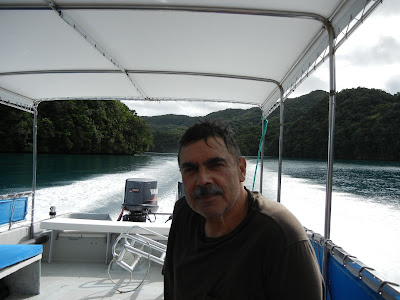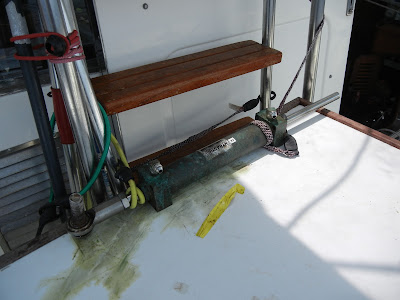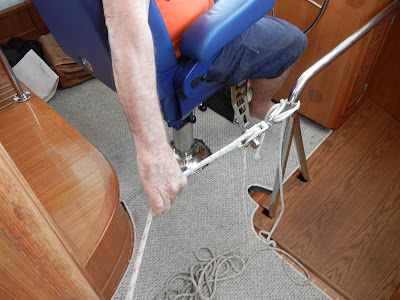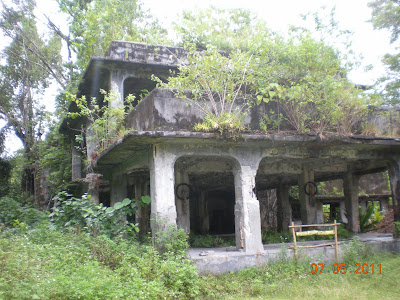Here are Phyl and I, along with all my direct progeny resting after the long climb to what we call the "Shining Place". It has a truly stupendous view of the Gros Ventre, Teton, Absaroka, Wyoming, Salt River and Wind River mountain ranges that always brings a tear to this old man's eyes.
On July 15th, I finally got to Astoria, and Arcadia II. On the 16th, my brother, Paul, and his friend, Irene , arrived. Her son, a longshorman from Seattle, was working nearby and joined us for a shore dinner.
On the 17th, we moved over to the fuel dock and topped off the fuel tanks. That put us nicely on an incoming tide and we were ready to head up the Columbia River. This was the very first time, since we bought Arcadia II, that we have actually gotten to use her. Heretofore, she's just been the proverbial "hole in the water", into which much money has been poured. It was a great feeling to be underway under my own command again. We finished that day by tying up to the public dock at Ranier, OR. The float lies parallel to the river current and I'm afraid I made a somewhat less than graceful upstream approach. Fortunately, there wasn't anyone around to see me have to go back around after the bow got away from us.
Ranier is a nice little town. We assumed that we could find a local supermarket within a short walk, so hadn't done any shopping for the galley before we left Astoria. That proved to be a flawed assumption. After a lot of walking, we found what looked like a supermarket, but proved to be some sort of overstock outlet that had a lot of stuff, but none of what we needed. We did find a nice enough restaurant, so we decided on a shore dinner. More walking led us to a gas station/convenience store in which we found enough for breakfast the next day.
On the 18th, we continued up the Columbia to Portland. The railroad bridge was down. I really didn't know what my air draft was and it looked like it would be a tight fit, but since we were travelling upstream, I approached it slowly while Paul watched the outriggers and antennae. At the last moment, it became obvious to him that the outriggers wouldn't clear the bridge in their stowed position. I backed off and went downstream to deploy the outriggers. The next attempt, he could see that the mast would clear well enough, but the radio antennae might drag a bit. We went on through, without laying them down. No damage was done, but with a lot of noise, we showered the boat with a lot of rust and stuff from the underside of the bridge. We finished the day by tying up at Tomahawk Bay Marina in Portland.
On the 19th, we continued up the river, on a very nice day, through the very scenic Columbia River Gorge to Bonneville Dam. River flow was high, so the current was strong and there was a good deal of turbulence in the water. The autopilot could barely hold course and progress was slow. When we contacted the lockmaster, he advised us it would be an hour before he could lock us up, and directed us to a float in the channel below the lock. After a nice dinner, the lock opened for us and we went through without incident, heading up to our intended evening stop at Hood River. By the time we got there is was well past dark and there was a heavy rain. We never actually left the boat that evening.
On the 20th, we locked back down through Bonneville Dam, without incident. A few words are in order about the locking process. The Corps of Engineers makes this process go very smoothly for pleasure boaters, which they do not mix with the commercial barge traffic. You simply call ahead to the lockmaster as soon as you are within low power radio range to find out when he will lock pleasure boats through, (You can also use your cell phone. The numbers for all the locks are in the common chart book that everyone uses.) At the appointed time, the lockmaster will direct you to enter the lock and tell you which position in the lock to go to. At each station, there is a bollard in a vertical channel in the lock wall. The bollards rise and fall with the water level in the lock. You just drop a loose loop of your breast line over the bollard and fend off by hand to keep your boat parallel to the lock wall, far enough off that your fenders don't have to drag on it. There is very little turbulence.
Once clear of Bonneville, we headed back to Tomahawk Bay. Going downstream was much more pleasant than coming up. The current was with us, so it was faster, of course. More important, we moved so much more quickly through the turbulent spots that they had little effect on our course. The autopilot maintained course with ease, making for an altogether enjoyable passage.
At one point, I had considered going on up river, perhaps as far as Lewiston, Idaho. However, this exploratory jaunt up to Hood River, and the drive-by look at the scenery that Willy and I did earlier, convinced me that such a trip on Arcadia II would be more arduous than fun. Accordinly, I decided to take a more permanent slip in Tomahawk Bay and just cruise the lower river for the time we had left. On the 21st, we rented a car at the nearby Portland airport and drove back to Astoria to get my own car while Paul and Irene could drive one vehicle back before they left for California.
After Paul and Irene left, I started in on my "to do" list. As we travelled, it was apparent that the main engine alternator was not charging the batteries. I took it ashore to be rebuilt, while I did routine things like changing oil in all the engines, pickling the watermaker and varnishing the gratifyingly small amount of teak this boat has exposed to the weather.
On the 26th, an old submarine shipmate, Warren Coughlin, and his wife Edye came aboard. We got underway for Government Island that evening. Once again, I blew an upstream tie to the float there and had to go around. This time, of course, there was a whole yacht club there to see it. After meeting a lot of nice folks on the float, we had a nice dinner aboard.
On the 27th, we shoved off and made the short run up the Columbia River Gorge before we returned to Tomahawk bay.
I continued getting the boat ready for the next passage until the afternoon of the 29th of July. At that point, I got in my car and drove to Bellingham to make arrangements for a haulout at SeaView North Boatyard. I left my car there and flew home from Bellingham on the 30th.
I didn't return until August 16th. In my absence, a new Sleep Number bed for the master stateroom had arrived and I installed it. The next day, my stalwart offshore travelling companion, Rudy Prendiz, arrived. On the way back from the airport, we stopped at a supermarket for last minute provisions for the passage up to Bellingham.
On the 18th, we left Tomahawk Bay and went back to Astoria, fueled up and had a nice shore dinner.
On the 19th, we timed our departure over the Columbia River bar at high slack and set an offshore course North on a lovely afternoon.
We rounded Cape Flattery the morning of the 20th of August, after an extraordinarily pleasant passage. That evening, we tied up at Port Angeles and had a lovely shore dinner with another good friend from my Navy years, Gailard Kunkle, and his wife, Carol.
On the 21st, Rudy and I again got underway, making a leisurely passage through the San Juan Islands to Roche Harbor, on San Juan Island, arriving in time to deploy the dinghy and attend their nightly "Colors"at sundown before a nice shore dinner there.
The next morning, we moved the boat around San Juan Island to Friday Harbor and spent the day playing shore tourist and shopping for LED navigation light bulbs. On the 23rd, we moved on to Bellingham and tied to SeaView North Shipyard's courtesy dock.
On the 24th, Rudy Prendiz left and our next door neighbors, Dave and Barb Drummond arrived on the same plane that Rudy took home. We stopped at a grocery store on the way back from thee airport, then departed for the San Juan Islands. We anchored in Blind Bay on Lopez Island that evening.
On the 25th, after Dave and Barb motored around Blind Bay andd over to Deer Harbor on Orcas Island, we moved back over to Roche Harbor on San Juan Island, again in time for Colors and yet another nice meal ashore. The next day, the 26th, was devoted to sightseeing around the harbor. Dave and Barb took a van tour over to Friday Harbor and back while I stayed aboard and enjoyed quiet time at anchor until they returned. We stowed the dinghy and got underway late that afternoon, arriving back at SeaView North after midnight.
On the 27th, Dave and Barb left for home and I made final arrangements for the haulout the next day.
Arcadia II was "on the hard" from the 28th of August until the 14th of September.
During that period we:
- Pressure washed and recoated the bottom with ablative anti-fouling paint.
- Scraped and grit blasted the two keel coolers, then coated them with Propspeed
- Removed and sent the main propellor to a shop for comprehensive servicing and polishing.
- Replaced the polymer stops in the Gori wing engine propellor and polished it.
- Replaced the hose "boot" between the hull shaft log and the packing gland for the main shaft.
- Inspected the main and wing shaft cutless bearings
- Replaceed the main shaft packing.
- Checked the main shaft for runout.
- Replaced the main engine rear seal and the entire torque spider between the flywheel and transmission.
- Checked main engine valve lash.
- Inspected the Naiad fin shaft bearings and replaced the outboard seals.
- Replaced the wind instruments masthead sender wheelhouse ST 60 receiver.
- Removed, rebuilt and reinstalled the Hurricane Heater.
- Replaced all zinc anodes.
- Replaced the masthead light with LED.
- Replaced spreader lights.
- Replaced the anchor windlass motor with a new on. Placed the "McGiver" repaired orginal in spares.
On the 15th, we moved on to Roche Harbor, launched the dinghy and went ashore. Dinner at McMillins, as always, was excellent.
On the 16th, we completed the passage across Juan de Fuca strait and tied up at our pre-arranged slip in the marina by noon. I borrowed Gailard's truck and took John Heller to SeaTac and his plane home that evening. I spent the next day retrieving my car from Bellingham.
My intent was to leave Arcadia II in the Port Angeles marina for the winter. I thought I understood the state of Washington's rules witth respect to use taxes. My research was flawed, however. After I got there I learned that boats with only USCG documentation and no State registration or boats owned by a corporation are ineligible for the one year exclusion from Use Tax that I expected to obtain. That would have meant that all the complexity and expense we had faced to prevent being liable for California Use Tax would have been simply replaced by an even higher tariff in Washington if we stayed in that state for longer than two months.
I stayed in Port Angeles only long enough to finally get the main engine alternator and regulator recommissioned and to replace the fuel booster pump on the Hurricane heater. On the 18th of September, we topped off the fuel tanks and did a short coastal cruise to check everything out.
On the 22nd of September, Gailard Kunkle and I left Port Angeles and took the boat to Van Isle Marina in Sydney on Vancouver Island. I took the ferry back on the 24th, retrieved my car in Port Angeles and drove back to California. Arcadia II can remain in Canada, without tax for 6 months.
Sometime before the middle of March, we'll move the boat back to Bellingham and wait until the weather allows us to head up to Alaska. I'm a long way from a commitment, but I'm beginning to explore the possibility of making a West to East transit of the fabled NW Passage across the Arctic.
The idea would be to be in Kodiak early in July. If the polar ice conditions already look promising at that time, and if weather in the Bering Sea permits, we'd move on around Alaska's north coast, cross through the NW passage above Canada to Greenland, then go down to the St. Lawrence and up to the Great Lakes to Chicago, then take the Chicago and Illinois Rivers to the Mississippi. If all went well, we'd come out on the Gulf of Mexico after hurrican season. After that. . .I dunno, yet.

























































